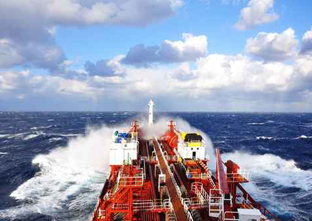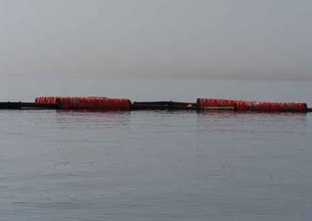
Tackling pollution
Not all disasters are natural
Mother Nature is not always to blame for all disasters at sea. An oil tanker sinking off the coast, for example… Can nothing be done about it? Happily, yes it can. But only by acting without delay. Once again, plastics can do the business.

Firstly – prevent spreading
 In an oil spill, or any other chemical pollution of oceans or rivers, the most urgent thing to do is to contain the polluting slick to stop it spreading. There has long been a way to do this – floating booms made from chlorosulphonated polyethylene, used for their excellent resistance to oxidizing chemicals (acids) and hydrocarbons. These cylindrical inflatable barriers are flexible enough to match the shapes of the waves – they can withstand gale force 9 winds – thus stopping the polluting materials from spreading. This type of barrier can also withstand high temperatures (+110°C) and comes in different lengths for different environments (sea, river, etc.).
In an oil spill, or any other chemical pollution of oceans or rivers, the most urgent thing to do is to contain the polluting slick to stop it spreading. There has long been a way to do this – floating booms made from chlorosulphonated polyethylene, used for their excellent resistance to oxidizing chemicals (acids) and hydrocarbons. These cylindrical inflatable barriers are flexible enough to match the shapes of the waves – they can withstand gale force 9 winds – thus stopping the polluting materials from spreading. This type of barrier can also withstand high temperatures (+110°C) and comes in different lengths for different environments (sea, river, etc.).
Secondly - drain or soak up…

Once the polluting material has been trapped within the barrier, it has to be disposed of. Here, it all depends on how close it is to the coast (or river bank). Out at sea, fireboat-style primary response vessels swing into action, and the polluting material is pumped into a barge before being carried to a port. Spills closer to the coast are channelled into retention basins dug into the ground, generally composed of completely impermeable, chemical-resistant PVC sheeting.
Finally, the plastics industry has also developed huge polypropylene sponges – of up to dozens of metres long,capable of soaking up hydrocarbon or any other kind of water-immiscible liquid pollution. Their enormous absorbency, light weight and ease of deployment make them perfect for tackling smaller slicks of polluting materials.
… and possibly, recycle
The 2010 Deepwater Horizon drilling rig explosion in the Gulf of Mexico and the subsequent oil spill are still fresh in memory. At the time, 160 km of floating booms were deployed to protect the coastlines. They were later recovered and recycled by US carmaker General Motors as part of a sustainable development initiative. Once cleaned of all traces of hydrocarbons, the plastic was then used to manufacture parts for the Chevrolet Volt: the company’s fully electric car… General Motors successfully converted the used oil booms into 45 tonnes of plastic resin pellets, making the Volt an especially eco-friendly vehicle.





